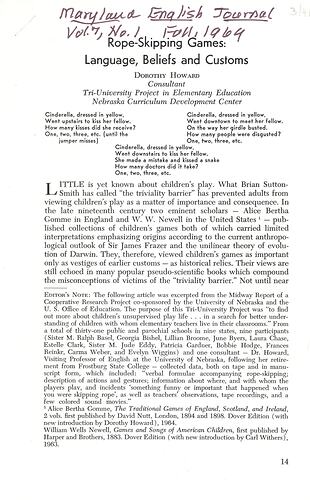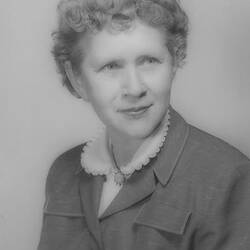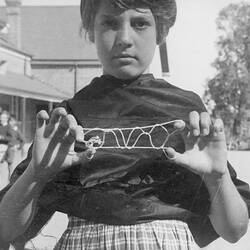Summary
Game types: rope-skipping, rope-skipping rhymes
Alternative game types: skipping games, language play, play with equipment/props
Article titled 'Rope-Skipping Games: Language, Beliefs and Customs' written by Dr Dorothy Howard and published in Maryland English Journal in 1968. Dr Howard discusses the shift from viewing children's games as historical relics to being worthy of rigorous academic investigation, particularly in the field of behavioural sciences. She suggests the study of rope-skipping games, played by children of six to twelve years, may further research in a number of areas notably developmental psychology, pedagogy, anthropology, history, psycho-linguistics and kinesics. Applying Jean Piaget's theory of the cognitive development of children, Dr Howard states that rope-skipping games provide an opportunity to examine a significant stage of children's development during which motor skills, problem solving and organisational skills improve. She argues that the accompanying rhymes reflect language development, social interests, imagination and popular culture. Dr Howard continues with an examination of the variety and content of rhymes which are inspired by family members, historical and literary figures, celebrities, animals and foods. Other rhymes are educational or offer advice on decorum; some are satirical protests against adult regulations and behaviour.
One of a collection of publications about children's folklore written by Dr Dorothy Howard. Dr Howard came to Australia in 1954-55 as an American Fulbright scholar to study Australian children's folklore. She travelled across Australia for 10 months collecting children's playground rhymes, games, play artefacts, etc. The original fieldwork she collected during this period is held in the Australian Children's Folklore Collection (ACFC) at Museum Victoria and includes index cards, letters and photographs.
Physical Description
Article with typed black text printed on paper. Three, unbound pages printed on both sides. Handwritten annotation in black ink along top of first page.
More Information
-
Collection Names
Australian Children's Folklore Collection, Dorothy Howard Collection
-
Collecting Areas
-
Acquisition Information
Cultural Gifts Donation from Dr June Factor, 18 May 1999
-
Acknowledgement
Donated through the Australian Government's Cultural Gifts Program.
-
Collector
-
Author
-
Publisher
Maryland English Journal, Maryland, United States of America, 1968
-
Person Named
-
Person Named
Lady Alice B. Gomme, 1894-1898
Dr Howard cites the research of Lady Gomme from 1894-98. -
Person Named
William W. Newell, 1968
Dr Howard cites -
Person Named
Jean Piaget, 1968
Dr. Howard cites Swiss psychologist Jean Piaget's theory of the cognitive development of children. -
Classification
-
Category
-
Discipline
-
Type of item
-
Overall Dimensions
153 mm (Width), 230 mm (Height)
Orientation: portrait
-
Keywords


